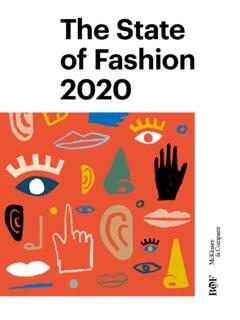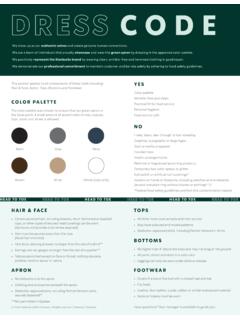Transcription of Apparel 2030 2025: What new business models will emerge?
1 May, 2020 Apparel 2030 2025: What new business models will emerge? Apparel 2030 2025: What new business models will emerge? 2 Scenario planning: Envisioning possible futures and crafting winning strategies for each The Apparel industry is undergoing exponential change, which the COVID-19 crisis will only accelerate through store closures and increased unemployment. Our hypotheses in this article, originally intended as scenarios for 2030, are based on research conducted prior to the downturn. Recent events increase the likelihood that these predictions will come to pass even sooner perhaps as soon as 2025. Even before COVID-19, Deloitte research estimated that Apparel incumbents in the United States could lose as much as 25% of their market share to new rivals as well as new commerce models1. The emerging competition includes marketplaces, such as Amazon and Alibaba, that are using transactional data to launch competitive products; alternative commerce models like subscription services, Apparel rentals, and recommerce (used-clothing sales); wholesalers going directly to consumers; overseas retailers; and pure internet players.
2 Apparel industry players around the globe can expect to be affected by these same forces (figure 1). MARKETPLACES*Marketplaces, like Amazon and Alibaba, are increasingly taking share from the Apparel market, driven by ease of checkout and user-friendly websites. ALTERNATIVE COMMERCE MODELSNew commerce models are affecting the way consumers are purchasing new and used Apparel . WHOLESALE BRANDS SELLING DIRECT TO CONSUMERS Wholesale brands are taking advantage of low direct-to-consumer barriers and their ability to create brand BRANDSNon-US-based brands are capitalizing on advanced supply chains, increased brand exposure, and strong online presence.$360$ ( )% ( )% Commerce ModelsWholesale D2 COverseas Brands20182023% Change Market ShareNew Concepts$271$30$24$13$22$208$60$46$45$30 Figure 1: New competitors will take share from incumbents*Marketplace estimates based solely on size of Amazon.
3 Sources: 1 Euromonitor 2019 Apparel Report; 2 Deloitte Consumer Survey, 3 Internet Retailer, 2019 Online Apparel Report, 4 AMZN, Raising L-T AWS Forecast on Cloud Survey Results, Forecast Cowen Equity Research, May retailer revenue growth ($US, billions)1-4 2018-20233As stores reopen and market volatility eventually subsides, progressive thinkers will contemplate what the industry might look like in the next five to ten years, and how the crisis will accelerate its transformation. Which business models will prevail? Who will lead the pack? We have already seen True Religion2 and Neiman Marcus3 file for bankruptcy who else will follow? Of course, predicting the future is a fool s errand, especially predictions made during economically uncertain times that center on the speed of adoption of new technologies or new business models (figure 2).
4 Figure 2: Retail predictions vs retail realityPredictionsRealityNevertheless, Apparel players can still prepare for the future. How? When planning how to emerge from the downturn, they can analyze the trends shaping the industry (both those independent of, and those accelerated by, COVID-19) and identify the most viable scenarios that could change their business models . Armed with those insights, they can assess road signs indicating which scenarios may be most likely to materialize, and pinpoint capabilities needed to succeed in each scenario. With these realities in mind, we identify some of the key emerging trends that could affect the Apparel industry most dramatically by 2030. We describe four scenarios that could become reality, depending on which directions the trends take. Then, we explore how industry players key functions (such as merchandising, product development, supply chain, and channels) will be affected in each scenario.
5 Finally, we delineate the road signs that companies should watch for to gauge which scenarios may most likely emerge by 2030, so they can build the capabilities required to succeed. ABOUT OUR RESEARCHThis article draws on primary and secondary research into trends in the Apparel , footwear , and accessories industry. We tested our hypotheses using a global survey that had approximately 7,000 respondents in six key markets: Brazil, China, France, India, Indonesia, and the United States. The survey asked respondents to consider their current shopping patterns and behaviors as well as their predictions for how their behaviors will shift by 2030. Please note, research for this study was completed in 2019, prior to the COVID-19 crisis in the Spring of 2020. Consumers checking-in through apps like Foursquare is the future of retailSource: CIOS hort-lived trendChecking-in never reached tipping point.
6 Potential for use of geotagging in sales will take massive shareSource: ExperianNot mainstreamPrevalence of flash sales has fluctuated over will be everywhere virtual stores in subwaysSource: CNNLow adoption Never expanded outside of South tech will be as big as the smartphoneSource: WiredStill emergingWearable tech just starting to gain popularity almost a decade responsible retail becomes the next big thing. Buy one give one takes offSource: The New YorkerShort-lived trendBuy one give one never took off. The future of retail is Macy s, not AmazonSource: GartnerMacy s stock down over 50% in the past yearPok mon Go inspires a changing retail environment for pop-up stores Source: Storefront MagazineTechnology focusShopping-ways focusStill emergingAfter Google Glass was first put forward over a decade ago, AR is just now gaining in commerce is the future of retailSource: emergingAbout 10% of US households have voice trends that could transform the Apparel industryA number of trends, driven by advances in digital tools and technologies, are coalescing to transform the Apparel -industry landscape.
7 These trends include the increasing impact of social influencers, faster fashion, higher discounting, more direct-to-consumer moves and global expansion by brands, and (of course) increasing e-commerce. Several of these trends are emerging at similar speeds around the globe. Others are gaining traction more rapidly in developing markets owing to the lack of infrastructure alternatives (figures 3 and 4).While most of these digital trends likely will accelerate given the change in buying behaviors due to COVID-19, we maintain that two trends, in particular, will exert a disproportionate impact on the Apparel industry s operating model in the coming decade: customized Apparel and alternative commerce models . Figure 3: Online purchasing of clothing, accessories , and footwear is on the riseFigure 4: Primary inspiration/influencers of Apparel purchases vary across countriesOffline activities influence purchases in developed countries more stimuli influence developed and developing social media influences purchases in developing countries the mostDeveloped countriesDeveloping countries16%43%8%23%In-store shoppingCatalogs/direct mail15%21%28%30%11%24%24%32%Friends/fami lyE-commerce websitesPrint mediaTelevision17%18%41%38%Influencer social mediaBrand/retailer social mediaSurvey question: Thinking about the future, which of the following do you expect to most inspire / influence you with respect to fashion in 2030?
8 Proportions of purchases made online todayIncrease in expectations of online purchases by 2030 Source: Deloitte 2019 multi-country Apparel consumer research studySource: Deloitte 2019 multi-country Apparel consumer research studyIndia15%+53%68%19%+45%64%39%+17%56% 19%+32%51%17%+33%50%17%+29%46%ChinaBrazi lUSIndonesiaFrance01020304050607080 Consumers changing expectations of online purchases, by country50%10%20%30%40%50%TREND I: CUSTOMIZED APPARELMany consumers today have some ability to customize Apparel to their own liking. Certain basic forms of customization think monograms and custom tailoring in the luxury men s suiting market have been available for a long time, for a price premium. More sophisticated forms, such as personalized recommendations based on past shopping behavior, or crowdsourcing of new personalized styles, are newer.
9 However, this trend has the potential to take off. Why? Technology has put us on the cusp of enabling consumers to modify every aspect of each article of clothing including trim, sizing, materials, and even fundamental design. Smaller players like Zozo, MTailor, and Within24 are already experimenting with clothing customized for the exact measurements of an individual consumer s body. What s more, 3D printing across industries is experiencing rapid growth; revenues of 3D printing overall are expected to jump from $16 billion in 2019 to $36 billion by 20245. Thus, fully customizable fabrics could become mainstream by 2030. For example, the Netflix hit show Next in Fashion highlighted fully bespoke customized 3D printed , while only 15 percent of consumers said they tried customized clothing in 2019, 33 percent reported expecting to try it in the future.
10 Drawing on our analysis of how quickly emerging business models have been adopted in the past, we estimate that players offering fully customizable Apparel could claim 10 to 30 percent of market share by 2030 (figures ). Retailers would likely embrace this change, with customization reducing the risks of being over inventoried. And with health concerns surrounding the crisis ( , limiting in-person shopping), the migration to customization may accelerate in the near term. We note that customization may vary significantly by geography, as demonstrated by Deloitte s 2019 fashion-consumer survey (Figure ).5 Fully customizable Apparel could claim 10 to 30 percent of market share by : Euromonitor USA Apparel and footwear Data Jan 2019 (File), GlobalStats. SEC-10K Filings for Ross and TJX, StatistaFigure : Product customization could claim more market share by 2030 Product Customization Current Market Share Likely Range by 2030: 10% 30%Potential Range by 2030: 5% 50%Off PriceTabletsApparel E-commE-BooksGoogle Chrome46%30%12%10%6%Penetration of New Technologies & business models After 10 Years6 Alternative commerce models could take as much as 9 percent share by 2023, 10-30 percent share by 2030, and significantly higher percentages after 2030.






